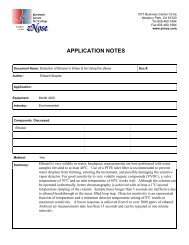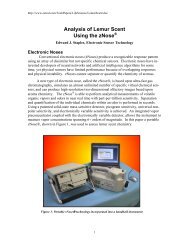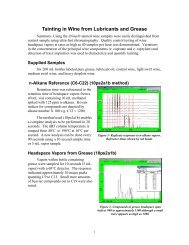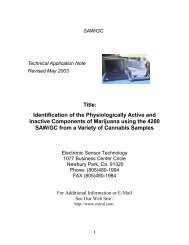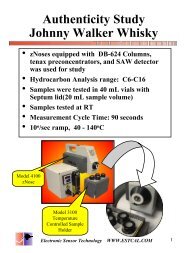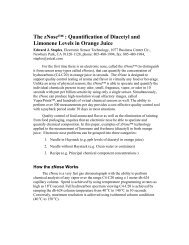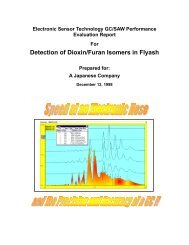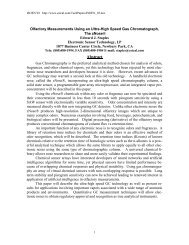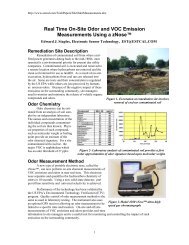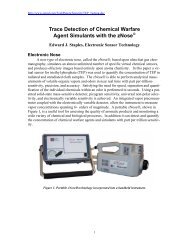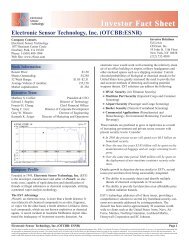A Portable SAW/GC Non-Intrusive Inspection System - Electronic ...
A Portable SAW/GC Non-Intrusive Inspection System - Electronic ...
A Portable SAW/GC Non-Intrusive Inspection System - Electronic ...
Create successful ePaper yourself
Turn your PDF publications into a flip-book with our unique Google optimized e-Paper software.
At the present time prototype <strong>SAW</strong>/<strong>GC</strong><br />
vapor analysis systems are being field tested<br />
under many different conditions. These tests<br />
include monitoring of VOC contamination of<br />
soil and groundwater at DOE SuperFund sites<br />
and as aids in training canines to detect drugs of<br />
abuse.<br />
In a recent field test, a prototype<br />
<strong>SAW</strong>/<strong>GC</strong> system participated in a Detection Assessment<br />
Program 4 sponsored by the U.S. Government.<br />
The instrument was first calibrated<br />
using a vapor generator. A typical scale factor<br />
for cocaine vapor was 17 Hz/pg. Large plywood<br />
boxes, 4 x 4 x 6 feet (2700 cu liters) as shown in<br />
Figure 4, were used to simulate cargo<br />
containers.<br />
In one test a 1 kg brick of cocaine was<br />
placed at the bottom of the container and al-<br />
<strong>SAW</strong>/<strong>GC</strong><br />
Sensor Head<br />
Upper<br />
Sampling<br />
Port<br />
Lower<br />
Sampling<br />
Port<br />
Figure 4- Plywood box with vinyl liner<br />
containing cocaine vapor source.<br />
lowed to equilibrate for 24 hours. Following a<br />
testing protocol, the room was sampled first and<br />
found to contain cocaine vapors but at a very<br />
low level. Next the container was tested. Ten<br />
second chromatograms of vapor samples taken<br />
at the top and bottom holes of the container are<br />
shown in Figure 5 and Figure 6. Sampling 10 cc<br />
of ambient air at the lower opening indicated<br />
cocaine vapors with a frequency shift of<br />
approximately 4000 Hz while at the top of the<br />
4 Cocaine and Heroin Vapor/Particle Detection <strong>System</strong><br />
Assessment Program, USCS93100, Rev. D (9-30-94).<br />
4<br />
Figure 5-Analysis of vapors taken at top of<br />
container.<br />
Cocaine Peak<br />
Amount Detected<br />
Figure 6- Analysis of vapors taken at bottom<br />
of container.<br />
container less than 100 Hz of frequency shift<br />
was observed. The results were quite repeatable<br />
and are consistent with vapor characteristics observed<br />
with other non-volatile materials. The<br />
detected frequency shifts are converted to<br />
cocaine vapor concentration in pg/liter factor in<br />
Figure 7.<br />
The actual measurements show a concentration<br />
less than 58 pg/liter at the top and a<br />
• 17 Hz/pg Scale Factor<br />
• Top:




